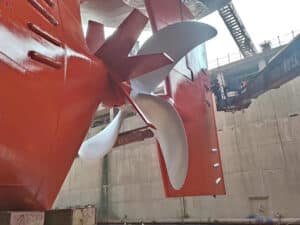
Inland Salvage completes salvage of jack-up in GoM
Written by Nick Blenkey APRIL 12, 2013 — Harvey, LA, based Inland Salvage, Inc. has completed the salvage of a retired jack-up drilling rig that sank in mid-December.
APRIL 12, 2013 — Harvey, LA, based Inland Salvage, Inc. has completed the salvage of a retired jack-up drilling rig that sank in mid-December.
The rig was under tow from Fourchon, LA, to be dismantled in Texas when it began taking on water. Despite being in the crowded waters of the oilfield, the tow captain was able to maneuver the sinking rig into a little used section of the Vermillion Block where the seas finally washed over the main deck and forced the rig to the ocean floor.
The Gulf of Mexico’s foul winter weather prevented any immediate salvage response, and the rig was left to the assault of high winds and rough seas. Soon a debris field could be seen coming from the wreck site and it was obvious that the rig would likely begin to break apart. Within a few weeks, the United States Coast Guard deemed the wreck a hazard to navigation and, although there was no fuel or environmental threat on board, demanded immediate action.
Inland Salvage was awarded the salvage contract and began dedicating assets towards the effort. After working together successfully on Hurricane Sandy response in the Northeast, ISI again decided to team up with Crowley Maritime subsidiary Titan Salvage of Pompano Beach, FL.
Titan’s naval architects began performing stability calculations while ISI and Titan personnel mobilized to the wreck site onboard a 185 class lift boat that could remain on location even during the Gulf’s winter storms.
Divers began underwater surveys of the vessel to inspect the damage to the structure and the condition of the jacking system. The Salvage Master, Gordon Olson , determined it would be best to approach the salvage from two fronts. One dive team would work to restore buoyancy to the barge and mud mat, while the second team would attempt to reestablish control of the now submerged jacking system. Salvage Engineers developed an external hydraulic supply and control unit that was connected to the existing jacking system by divers working in the confined spaces of the rig. At the same time, divers penetrated into the barge tanks to install salvage pumps and restore the rig’s dewatering system for the mud mat. There were several delays in progress as weather fronts moved across the Gulf, but crews were able to remain on site safely jacked up above the sea conditions in the lift boat.
With the work complete and a break in the weather, the process of raising the barge using its own jacking system began. The hydraulic repairs were successful and the barge slowly moved up the rig’s legs. As the main deck broke the waters surface, Salvors began pumping the barge to lessen the load on the hydraulic jacks. This continued until the barge was completely jacked up out of the water. Crews then evaluated the condition of the barge to develop a plan that would make her seaworthy again. With severe structural corrosion of the vessel requiring significant repair work and a short window of good weather, it was decided to set the jack up onto a receiver barge that could safely survive the trip to the scrap yard.
The rig was jacked high enough above the water to allow an ocean going receiver barge to be floated underneath of it. Once the floating vessel was in position, the jacks began lowering the rig onto the receiver deck. The rig’s mud mat was then raised up under the receiver barge and the tow was underway. The barge and rig combination safely arrived at its destination where the process was reversed and the jack up rig successfully delivered.
Inland Salvage worked closely with the United States Coast Guard during all phases of the operation. Daily safety and job task meetings were conducted to insure that all participants in the salvage were aware and prepared for the daily activities. The resources of all personnel were directed towards one common goal: a well planned and safely executed operation.





Leave a Reply
You must be logged in to post a comment.